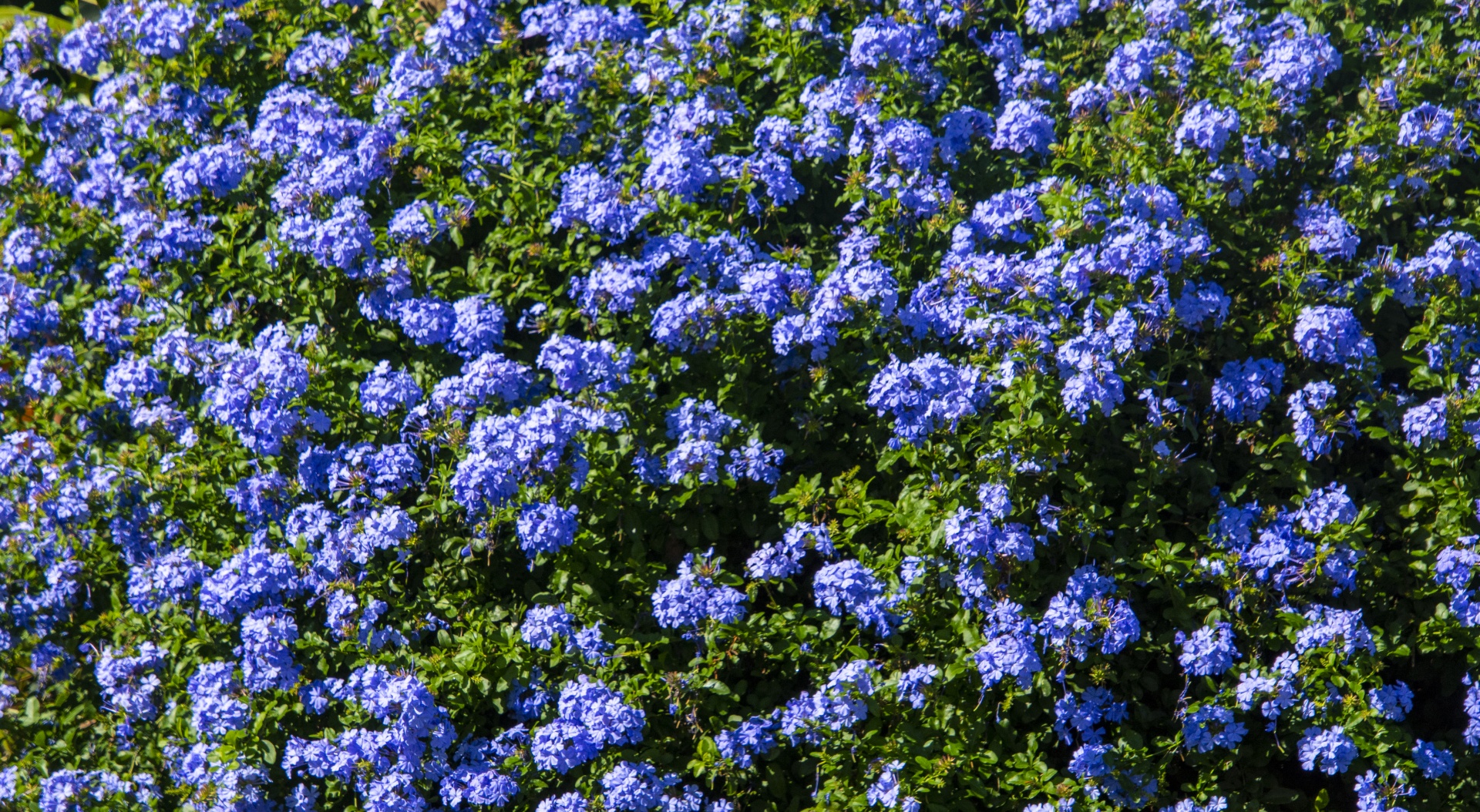
Plumbago, a genus comprising several species of flowering plants, has captured the hearts of gardeners and horticulturists around the world with its dazzling beauty and ability to thrive in tropical and subtropical climates.
Gulf Coast gardeners may find three species available within the Plumbago genus, each possessing its own unique characteristics and charm.
Plumbago auriculata
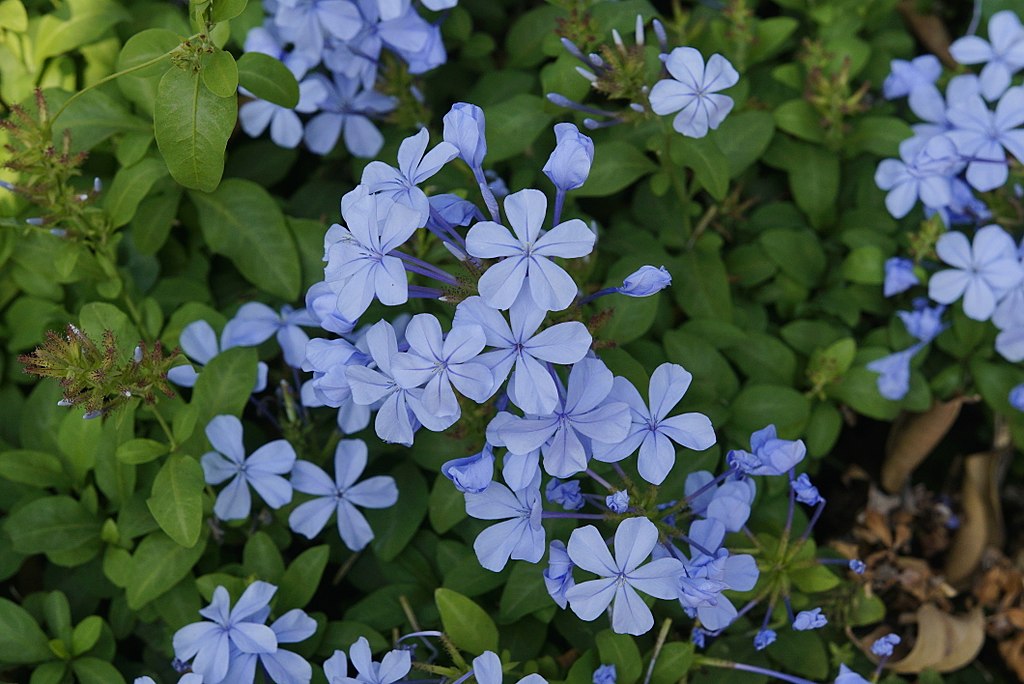
Originating from South Africa, Plumbago auriculata, commonly known as Cape leadwort, Cape Plumbago, or blue plumbago, thrives in the Gulf Coast region of the United States. This is the species you will most likely encounter in commercial nurseries. It is most often a light to bright blue, but you can also find a white variety of the flower.
In its native habitat, this evergreen shrub thrives in a variety of environments, from rocky slopes to coastal dunes.
It’s a versatile and visually striking plant. It typically grows into a dense, rounded shrub, reaching an average height of 6 to 10 feet with a spread of 6 to 8 feet. Its glossy, deep green leaves are elongated and lance-shaped, creating an elegant backdrop for the plant’s vibrant blue flowers.

Blue Plumbago is known for its proliferation of flowers. Throughout the warm months, usually from late spring to fall, even into winter in zones 10 and 11, the plant offers multiple clusters of tubular flowers in hues ranging from white to pale sky blue to deep cobalt blue. The delicate blossoms, about 1 inch in diameter, have a very subtle fragrance and attract various pollinators, including bees and butterflies.
When it comes to hardiness zones, it thrives in zones 8 to 11 within the U.S., making it a suitable choice for gardeners along the Gulf Coast and other mild-winter regions. However, in colder areas, it can be grown in containers and brought indoors during the winter months.
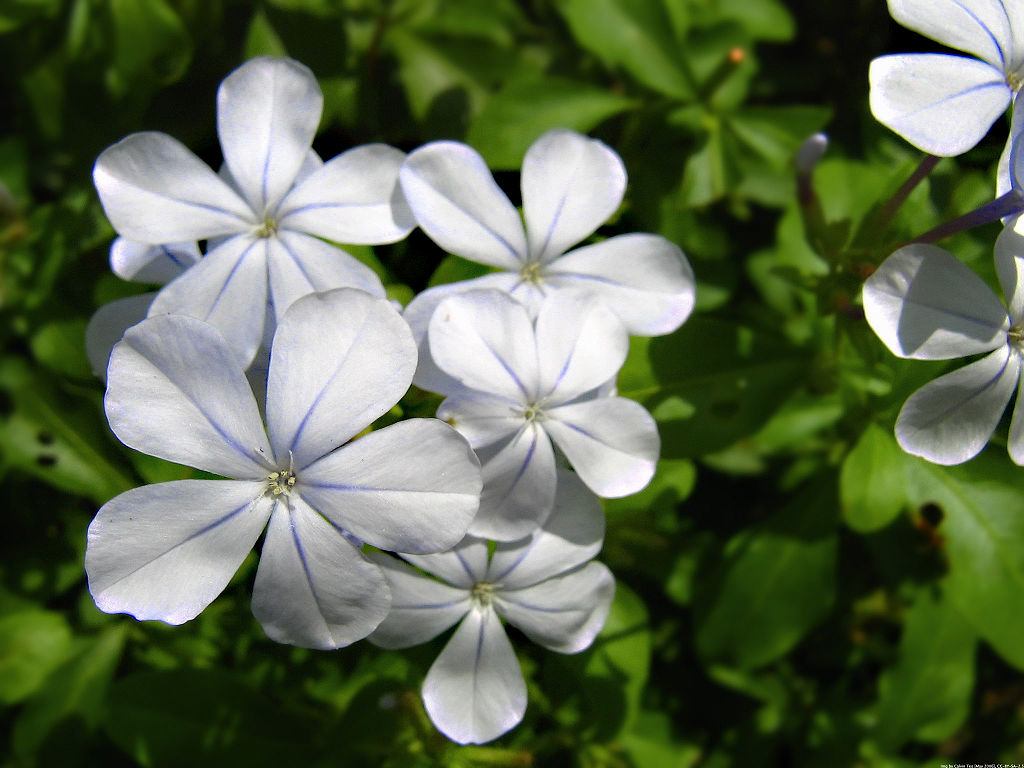
Species care details
To achieve optimal growth and bloom, provide Plumbago auriculata with full sun to partial shade. This species is adaptable to a wide range of soil types, but it prefers well-draining soil enriched with organic matter. Regular watering is necessary, especially during drier periods, to maintain healthy growth.
This is one of the most reliable landscape ornamentals in my garden, and I find that it’s very fussy (hungry and thirsty) for the first three years but after that, it flourishes with very little care.
The plant’s nectar-rich flowers serve as a valuable food source for pollinators, while its foliage offers shelter for various insects and small animals. I frequently find Florida anoles napping in the branches.
Several butterfly species, such as the Zebra Blue (Leptotes plinius) and the Common Blue (Polyommatus icarus), utilize this species as a host plant for their larvae.
Plumbago indica (or Plumbago rosea):
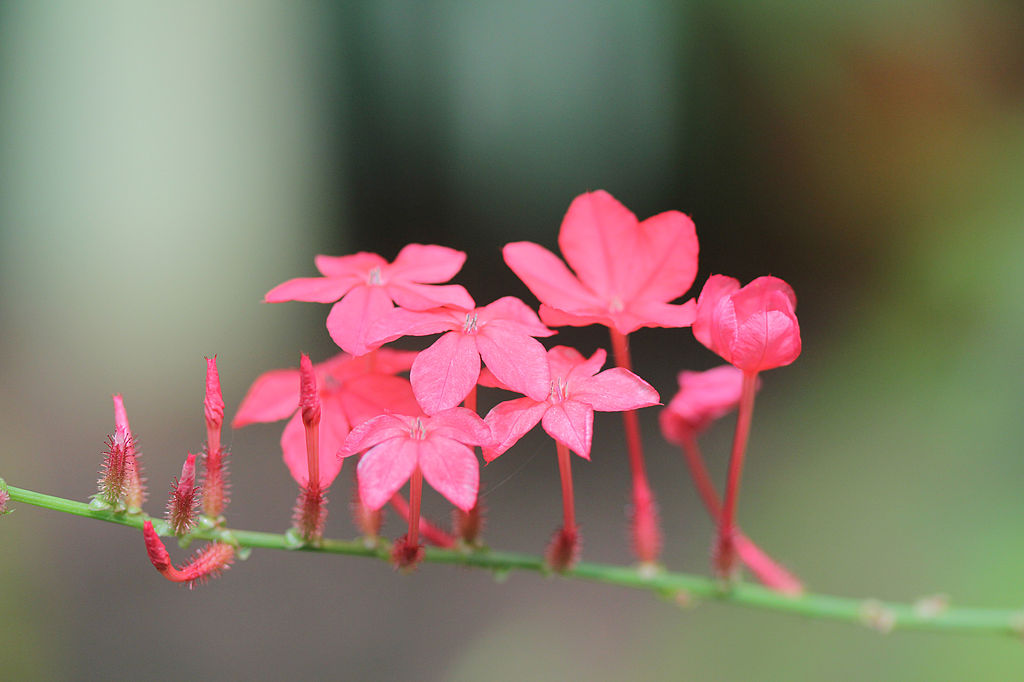
Plumbago indica (or Plumbago rosea), commonly known as Indianleadwort or red plumbago (or pink plumbago), is from India, so does wonderfully along the Gulf Coast in our hot, humid climate.
In its natural habitat, it thrives in the tropical and subtropical regions of Asia, including India and Sri Lanka. This species has adapted to a variety of environments, from open woodlands to rocky hillsides and coastal areas.
The plant itself presents a graceful and compact form, growing up to 3 to 6 feet in height and spreading 3 to 4 feet wide. Its slender branches bear lush, dark green leaves that create an attractive backdrop for the blossoms to come.
When it comes to flowering, this species offers a stunning display of vibrant red or pink clusters. These tubular flowers, measuring about 1 inch in diameter, emerge in abundance throughout the warm months, from spring to fall. The delicate blooms emit a gentle fragrance, attracting butterflies and hummingbirds to the garden.
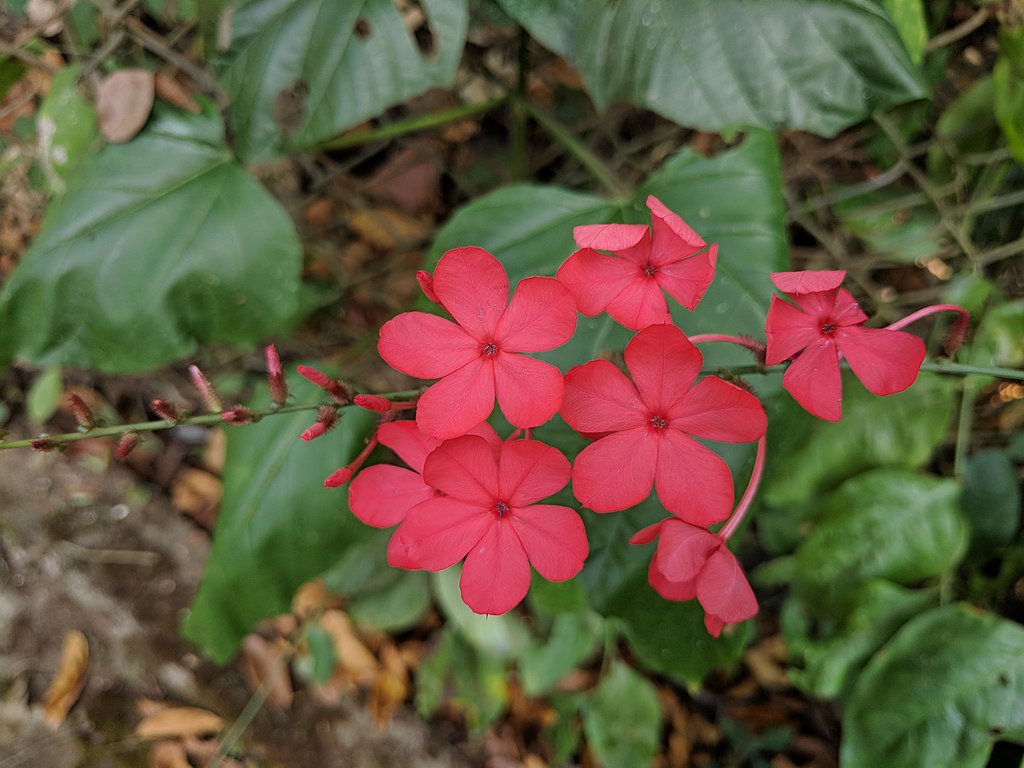
Species care details
In terms of hardiness zones, Plumbago indica thrives in zones 9 to 11 within the U.S. It appreciates full sun to partial shade and prefers well-draining soil that is rich in organic matter. Regular watering is essential for optimal growth and flowering, particularly during dry periods.
The flowering season coincides with the warmer months, providing a refreshing burst of color to gardens and landscapes. Its abundant flowers and compact growth habit make it an excellent choice for borders, hedges, or container gardening.
Plumbago zeylanica
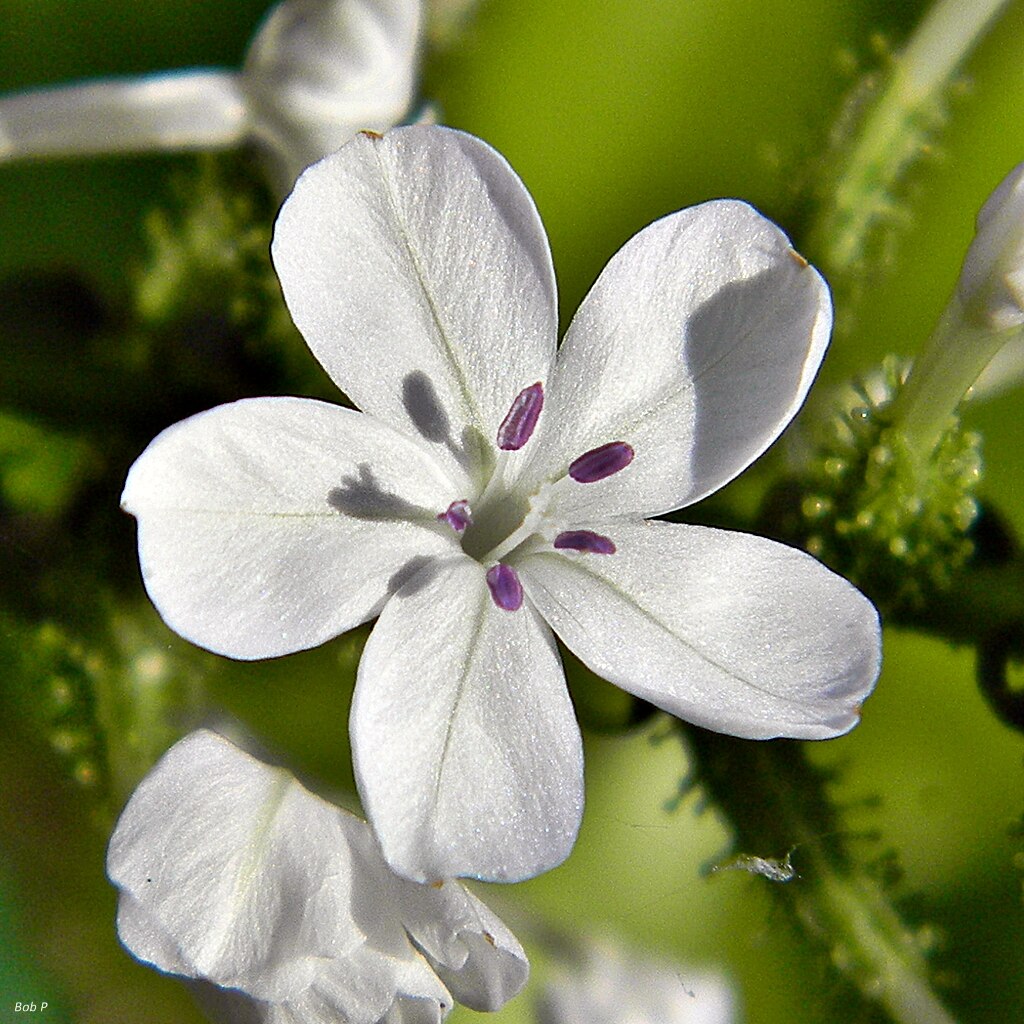
Hailing from tropical regions of Asia, but also native to coastal regions of Florida, Plumbago zeylanica, also known as Ceylon leadwort or wild plumbago, possesses a natural allure. This herbaceous perennial has made its mark in various ecosystems and now finds itself cherished by gardeners in the Gulf Coast region and beyond.
Wild Plumbago is not as showy as the other two species we’ve discussed, but it has the benefit of being a Florida native plant, supporting our unique ecosystems.
It thrives in diverse habitats, including grasslands, open forests, and scrublands. Its adaptability allows it to flourish in a range of soil types, from sandy to clayey compositions.
The plant itself displays a unique growth habit, forming clumps of sprawling, vine-like stems that reach a height of 1 to 3 feet. Its lance-shaped leaves, arranged alternately along the stems, add an attractive touch of green to the landscape.
Plumbago zeylanica showcases clusters of pale blue or white blossoms. These tubular flowers, about 0.5 inch in diameter, bloom throughout the warm months, from spring to fall. The delicate flowers emit a faint, sweet fragrance that entices pollinators, including bees and butterflies.

Species care details
This species typically grows in zones 9 to 11 within the U.S., where it thrives in the warm and humid conditions of the Gulf Coast region. It prefers full sun to partial shade and well-draining soil enriched with organic matter. Regular watering is necessary to maintain its lush foliage and promote healthy growth.
The flowering season coincides with the warmer months, providing a delightful display of pale blue or white flowers. Its sprawling growth habit makes it an excellent choice for ground cover, cascading over walls, or spilling out of containers.
Plumbago zeylanica attracts various pollinators, contributing to the local ecosystem. While specific wildlife interactions may vary, Wild Plumbago is known to support the life cycles of several butterfly species.
Planting Plumbago: Creating a Beautiful Foundation
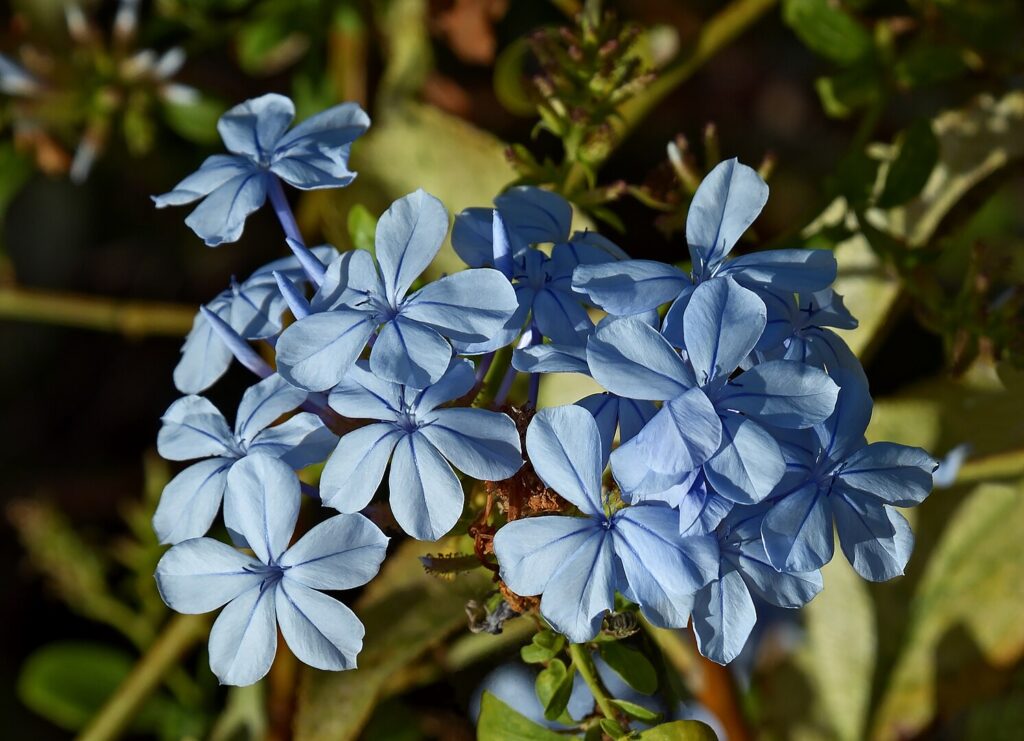
Plumbago brings a touch of tropical splendor to any Gulf Coast garden with its abundant flowers and ease of care. Plumbago is what they call “a doer” in the garden. It delivers nearly year-round and once established, it sets the foundation for a lush tropical landscape.
Choosing a Location to Plant Plumbago:
Selecting the right location for planting is crucial to its growth and overall health. Consider the following factors when choosing a spot:
Sunlight
This species thrives in full sun to partial shade. Choose a location that receives at least 6 hours of direct sunlight per day for optimal growth and flowering.
Soil Drainage
Plumbago prefers well-draining soil to prevent waterlogging, which can lead to root rot. Ensure the chosen location has soil that allows water to drain freely.
Space
Consider the mature size of the species you are planting. Allow enough space for the plant to spread and grow without overcrowding other nearby plants.
Step-by-Step Instructions for Planting a Plumbago Plant
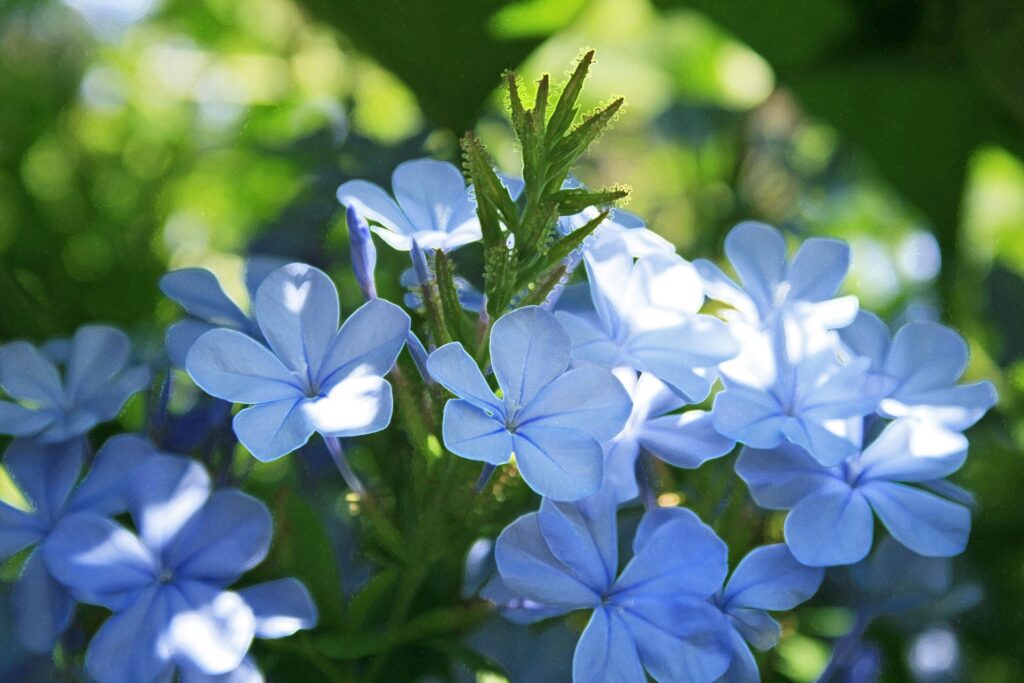
Once you have chosen the ideal location, follow these steps to plant Plumbago:
Prepare the soil:
Dig a hole that is wider and slightly deeper than the root ball of the plant.
Loosen the soil in the hole to allow for easy root penetration.
Preparing the plant:
If the plant is in a container, gently remove it by tapping the sides of the container or squeezing the base. Avoid pulling the plant out forcefully to prevent root damage.
If the plant is root-bound, tease out the roots gently to encourage outward growth.
Planting the Plumbago:
Place the plant in the center of the hole, ensuring that the top of the root ball is level with or slightly above the surrounding soil.
Backfill the hole with soil, gently pressing it down to eliminate air pockets.
Water the plant thoroughly to settle the soil around the roots.
Mulching:
Apply a layer of organic mulch, such as wood chips or bark, around the base of the plant. This helps retain moisture, suppresses weeds, and insulates the roots.
Caring for Plumbago: Nurturing the Tropical Beauty

Plumbago, with its vibrant blooms and lush foliage, requires proper care to thrive and reach its full potential. Let’s delve into the details and discover how to care for these tropical beauties.
Light Requirements
It thrives in full sun to partial shade. It benefits from at least 6 hours of direct sunlight each day to promote healthy growth and abundant flowering.
Soil Conditions
Plumbago prefers well-draining soil that retains some moisture but does not become waterlogged. A loamy or sandy soil enriched with organic matter provides an ideal growing medium.
Soil pH:
Plumbago tolerates a wide range of soil pH levels, from slightly acidic to slightly alkaline. A pH range of 6.0 to 7.5 is generally suitable for optimal growth.
Climate Preferences
This plant is well-suited for tropical and subtropical climates. It thrives in warm and humid conditions, making it an excellent choice for the Gulf Coast region and similar regions.
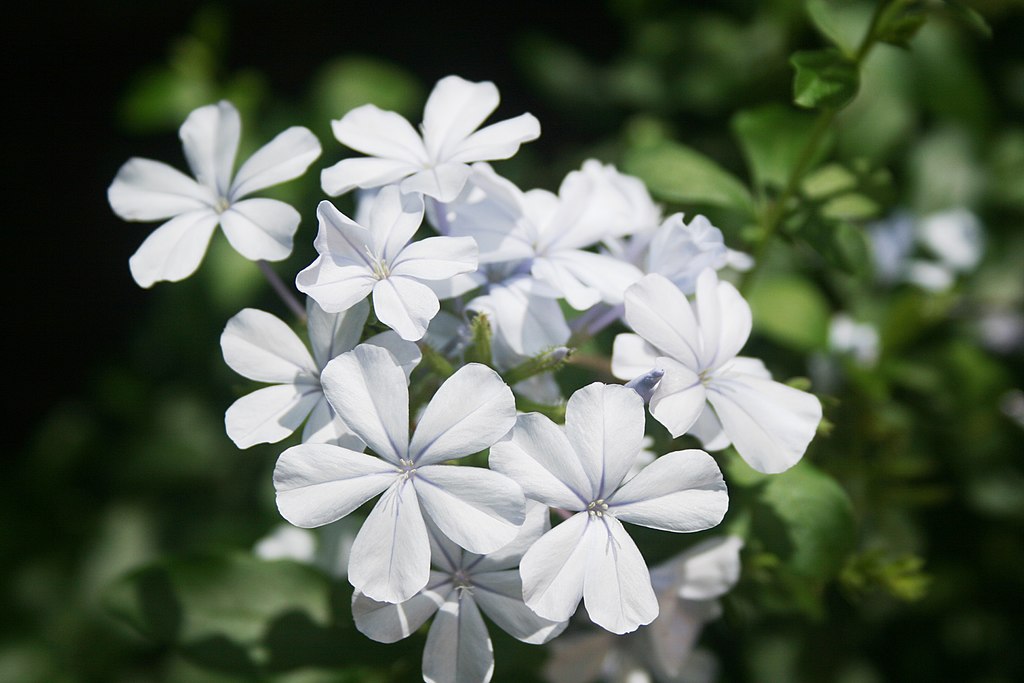
Temperature Tolerances
Despite its tropical origins, plumbago is surprisingly hardy.
Optimal Temperature
It thrives in temperatures ranging from 70°F to 90°F (21°C to 32°C).
Temperature Limit for Growth
It may slow down its growth when temperatures drop below 50°F (10°C).
Temperature Causing Damage
Plumbago can suffer damage when exposed to temperatures below 32°F (0°C). Frost or freezing conditions can cause wilting, browning, and leaf drop.
Effects of High Temperatures
It can tolerate high temperatures, but extreme heat, especially when combined with prolonged drought, can lead to stress, wilting, and reduced flowering.
Protection from Cold
In regions with colder winters, provide protection for your plant during freezing temperatures. Mulch around the base of the plant to insulate the roots, and cover the plant with a frost cloth or blanket. If grown in containers, move them to a protected area or indoors during winter.
Elevation Concerns
Plumbago does not have specific elevation concerns and can be grown successfully at various elevations.
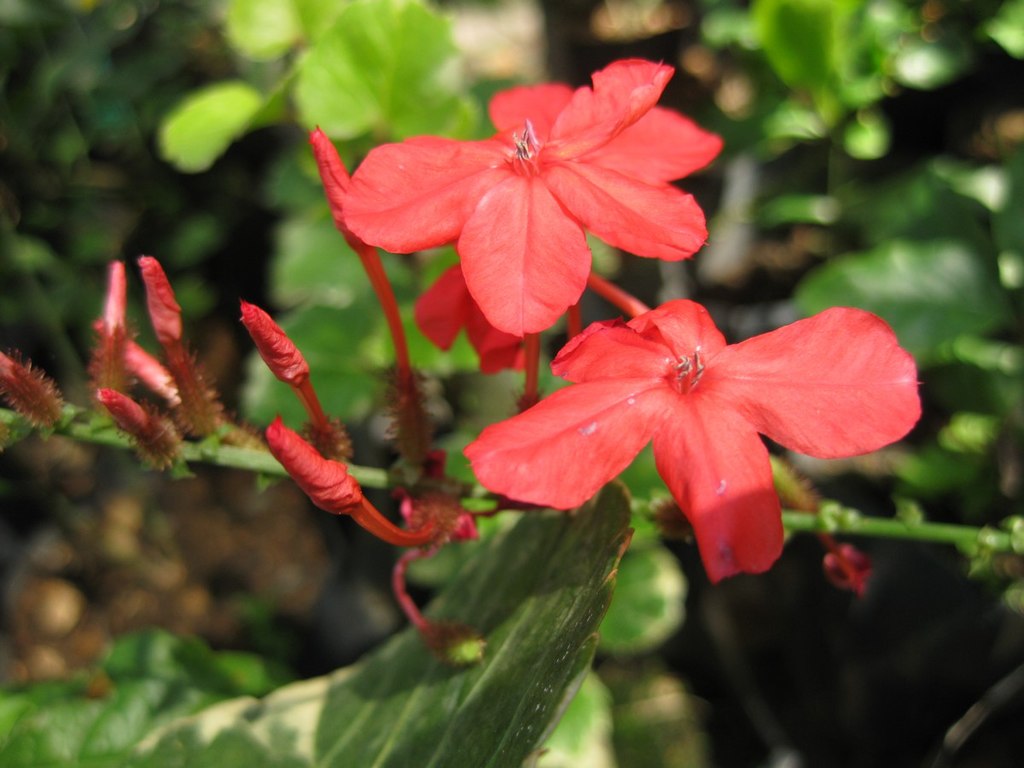
Watering Schedule
Water Plumbago regularly to keep the soil evenly moist but not waterlogged. Adjust the watering schedule based on weather conditions and rainfall. A general guideline is to provide deep watering once or twice a week during the growing season and reduce frequency during cooler months.
Fertilization
Adjust your plumbago’s feeding schedule to the season.
Leafing Out
In early spring when new growth appears, apply a balanced slow-release fertilizer according to the manufacturer’s instructions.
Blossoming
As the plant prepares to bloom, switch to a fertilizer higher in phosphorus to promote flower production. Follow the product recommendations for application rates.
Pre-Winter or Over Winter
In late summer or early fall, apply a balanced fertilizer to support root development and overall plant health before winter dormancy.
Pruning Schedule
Prune in late winter or early spring, before new growth emerges. Follow these steps:
- Remove any dead, damaged, or crossing branches.
- Prune back about one-third of the plant’s height to promote compactness and encourage new growth.
- Lightly shape the plant to maintain an appealing form.
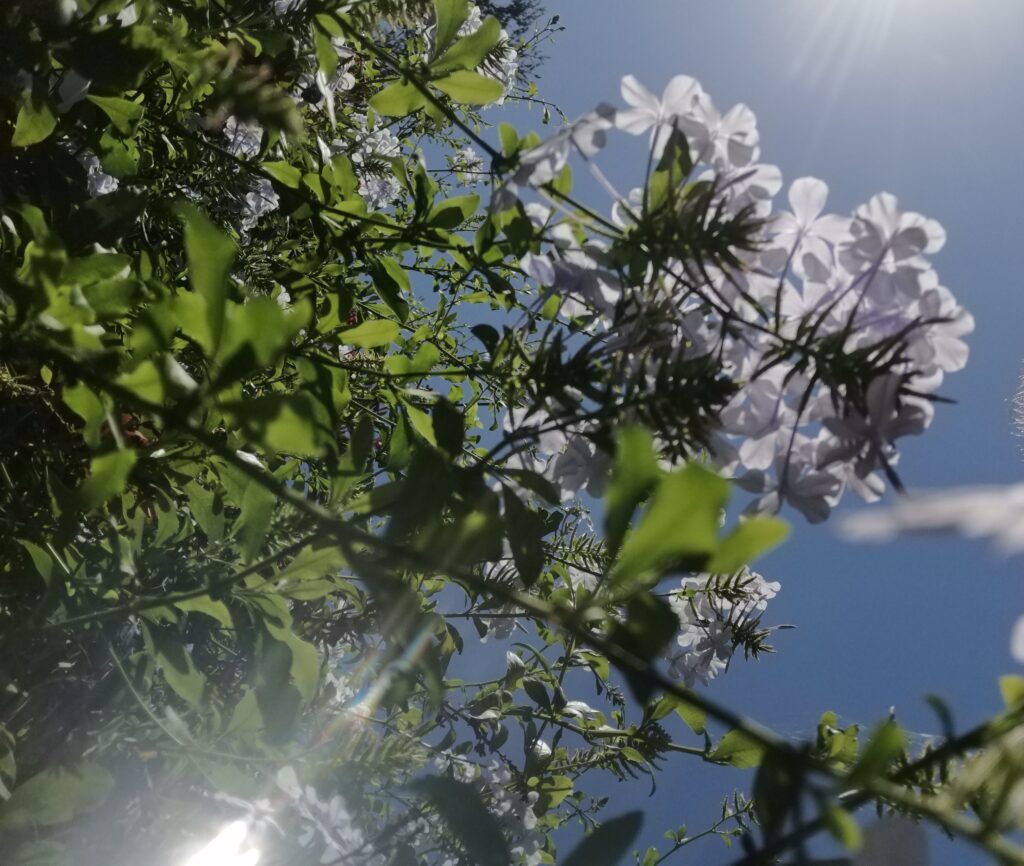
Common Pests and Diseases
Plumbago is generally resistant to pests, but it can suffer from disease.
Common Pests
Aphids: Use insecticidal soap or a neem oil-based spray to control aphids. Rinse the plant with water or use a gentle stream to dislodge them.
Whiteflies: Use yellow sticky traps or apply an insecticidal soap or oil spray to manage whiteflies.
Spider mites: Spray the plant with water to remove mites or use an insecticidal soap or horticultural oil for control.
Jack’s Dead Bug is an organic solution that uses a naturally occurring bacteria that has worked well for me for many pest problems.
Common Diseases:
Powdery Mildew: Ensure good air circulation and avoid overhead watering. Apply a fungicide labeled for powdery mildew if necessary.
Leaf Spot: Remove and destroy infected leaves. Maintain proper spacing and avoid overhead watering to reduce leaf spot occurrence.
Root Rot: Ensure proper drainage and avoid overwatering. Treat with a fungicide if root rot is detected.
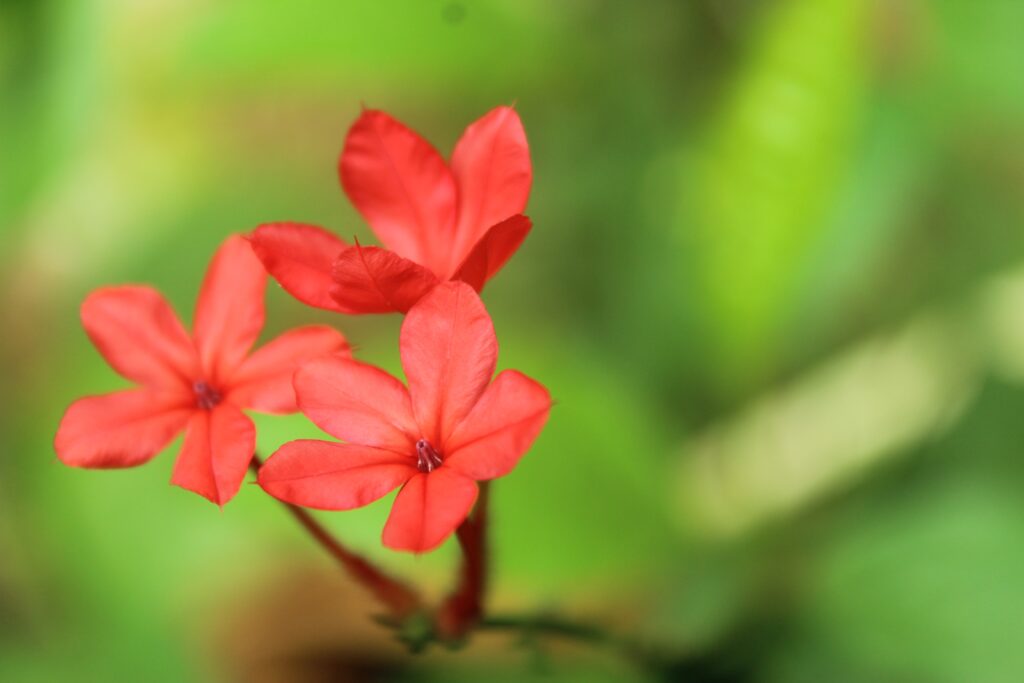
Special Care Considerations
Plumbago may require regular pruning to maintain a compact shape and encourage abundant flowering.
Regularly monitor moisture levels to prevent overwatering or drought stress.
Apply a layer of organic mulch around the base of the plant to conserve moisture, suppress weeds, and protect the roots.
Provide support, such as a trellis or stakes, if growing a climbing variety of Plumbago.
Propagating Plumbago
Now that you’ve planted your plumbago and it’s growing nicely, you may decide you want more. What’s better than free plants?
Here’s how you do it:
Propagating Plumbago from Cuttings
Taking cuttings and rooting them in a soft, light medium is the easiest way to grow more plumbago from your existing plants.
Select a healthy stem
Choose a non-flowering stem from the parent plant that is free from any diseases or pests.
Prepare the cutting
Using clean, sharp pruning shears, cut a 4-6 inch section of the stem just below a node (where leaves emerge).
Remove lower leaves
Remove the lower leaves from the cutting, leaving only a few leaves at the top.
Hormone application (optional): Dip the cut end of the cutting into a rooting hormone powder or gel, following the product instructions.
Plant the cutting
Insert the cut end of the cutting into a well-draining potting mix, ensuring that at least one node is below the soil surface.
I use a 50/50 mix of coconut coir and perlite, which stays moist without going anaerobic.
Provide optimal conditions
Place the pot in a warm, bright location with indirect sunlight. Maintain a consistently moist but not waterlogged soil.
Rooting process
Over the next few weeks, roots should begin to develop. Monitor the soil moisture and mist the cutting occasionally to maintain humidity.
Transplanting
Once the roots have formed, typically within 6-8 weeks, carefully transplant the rooted cutting into a larger container or desired planting location.
Here’s an excellent video showing the process step by step.
Propagating Plumbago from Air Layering:
Air layering is another technique that many use to grow more plants. For many plants, it’s a more reliable way to ensure rooting.
Select a healthy stem
Choose a healthy, non-flowering stem from the parent plant that is flexible and suitable for air layering.
Make a wound
With a sharp knife or pruner, make a 1-inch (2.5 cm) diagonal cut halfway through the stem, just below a node.
Apply rooting hormone (optional)
Apply a rooting hormone powder or gel to the exposed area of the wound to stimulate root development.
Moss and plastic wrap
Moisten sphagnum moss and wrap it around the wounded area. Enclose the moss with plastic wrap, securing it with twine or a rubber band at the top and bottom.
Alternatively, you may want to try air layering pods or propagation balls to ensure the sphagnum stays moist.
Provide moisture and wait
Keep the moss consistently moist by misting or watering as needed. After a few weeks to several months, roots will develop within the moss.
Check for root development
Once roots have formed and are visible through the plastic wrap, carefully cut below the rooted section of the stem.
Plant the new plant
Remove the plastic wrap and moss, and plant the rooted section in a well-draining potting mix or desired planting location.
Provide post-transplant care
Water the newly planted cutting thoroughly and keep it in a warm, bright location with indirect sunlight. Continue to care for it as you would for an established Plumbago plant.
By following these step-by-step instructions for propagating Plumbago from cuttings and air layering, you can expand your collection and share the beauty of these plants with others.
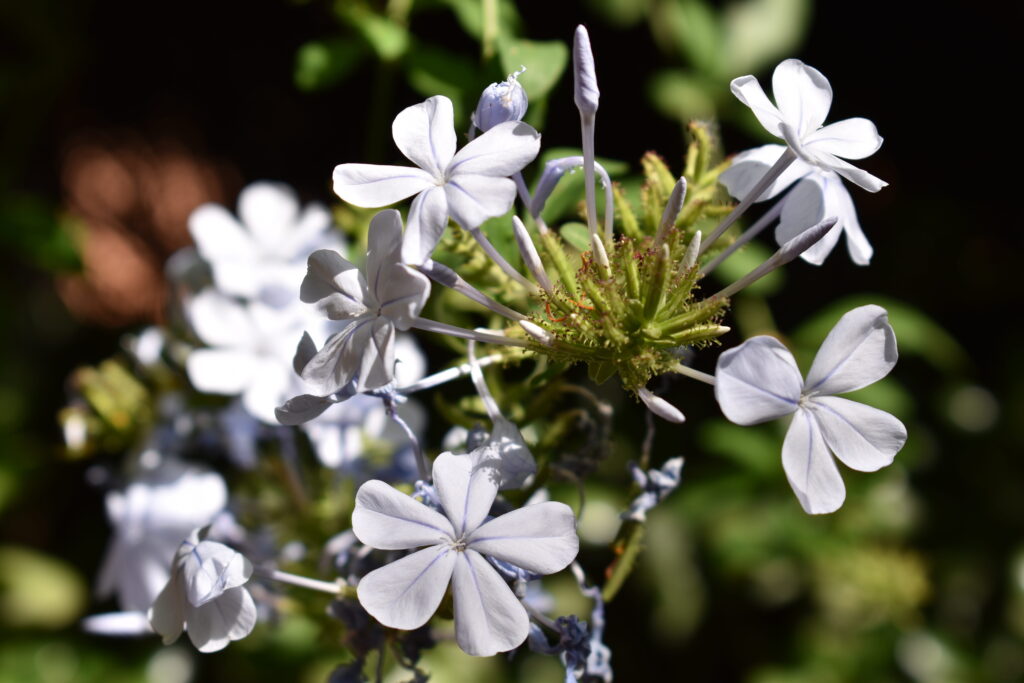
Landscaping with Plumbago
Use Plumbago as a vibrant hedge or border planting. Incorporate it into mixed shrub beds for pops of color.
Plant it near fences, trellises, or pergolas, and train it to climb for vertical interest.
Utilize containers and place Plumbago on patios, decks, or balconies to create a tropical ambiance.
Complementing Plumbago
Combine Plumbago with other colorful flowering plants in butterfly or hummingbird gardens. Here are some ornamental plants that can thrive alongside Plumbago while creating a harmonious and visually appealing landscape:
Native Lantana (Lantana involucrata and Lantana depressa)
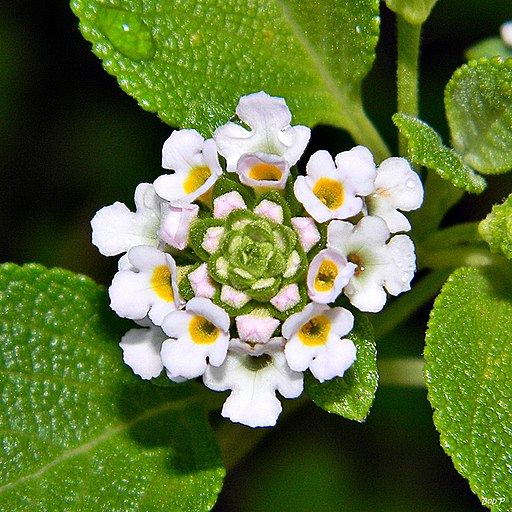
Lantana’s colorful clusters of flowers in various shades, including yellow, orange, and pink, complement Plumbago’s blooms. It is also a pollinator magnet, attracting butterflies and hummingbirds.
Pentas (Pentas lanceolata)
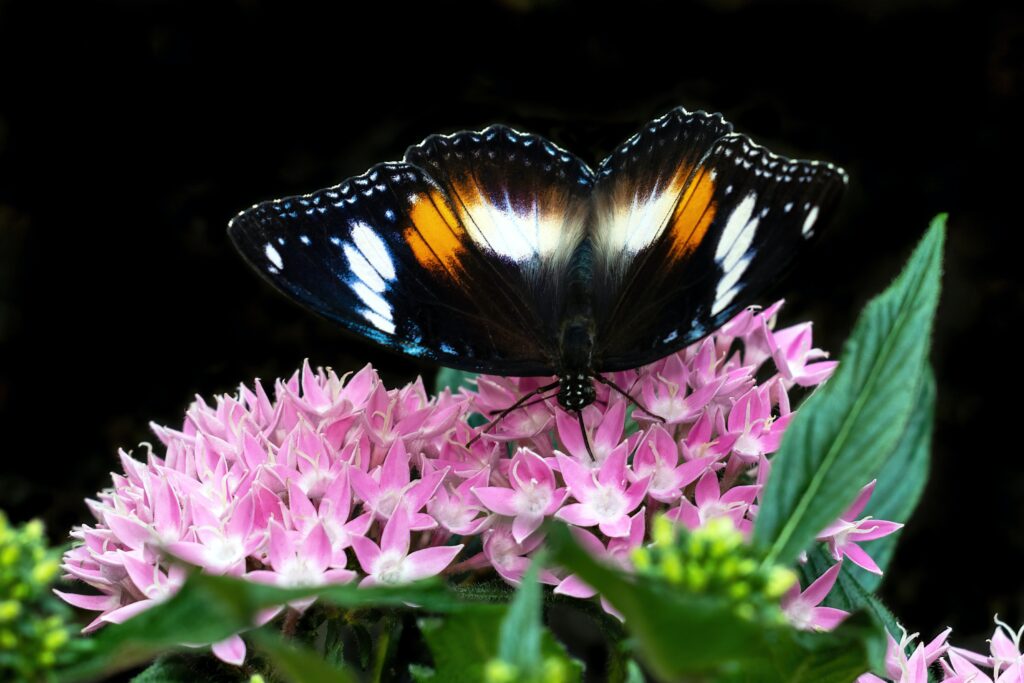
Pentas produces clusters of vibrant star-shaped flowers in colors such as red, pink, and white. It attracts pollinators and adds a burst of color alongside Plumbago.
Mexican Bush Sage (Salvia leucantha)
Mexican Bush Sage features striking velvety purple or white flower spikes that add vertical interest and contrast to Plumbago’s mounding growth habit. It is also a favorite of hummingbirds.
Duranta (Duranta erecta)
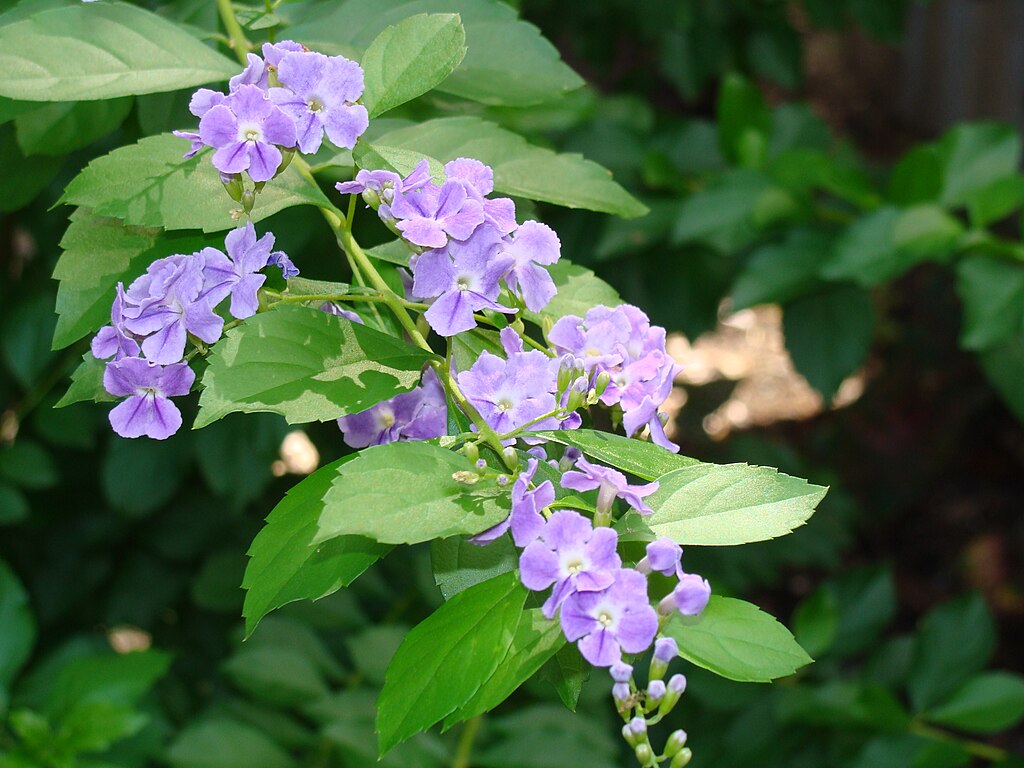
Duranta displays clusters of vibrant blue or purple flowers, adding a complementary color contrast to Plumbago. Its glossy foliage and cascading growth habit make it an excellent choice for borders or hanging baskets.
Dwarf Poinciana (Caesalpinia pulcherrima)
Dwarf Poinciana features striking red, orange, or yellow flowers reminiscent of miniature bird-of-paradise blooms. Its vibrant colors can create a stunning visual impact alongside Plumbago.
Tropical Hibiscus
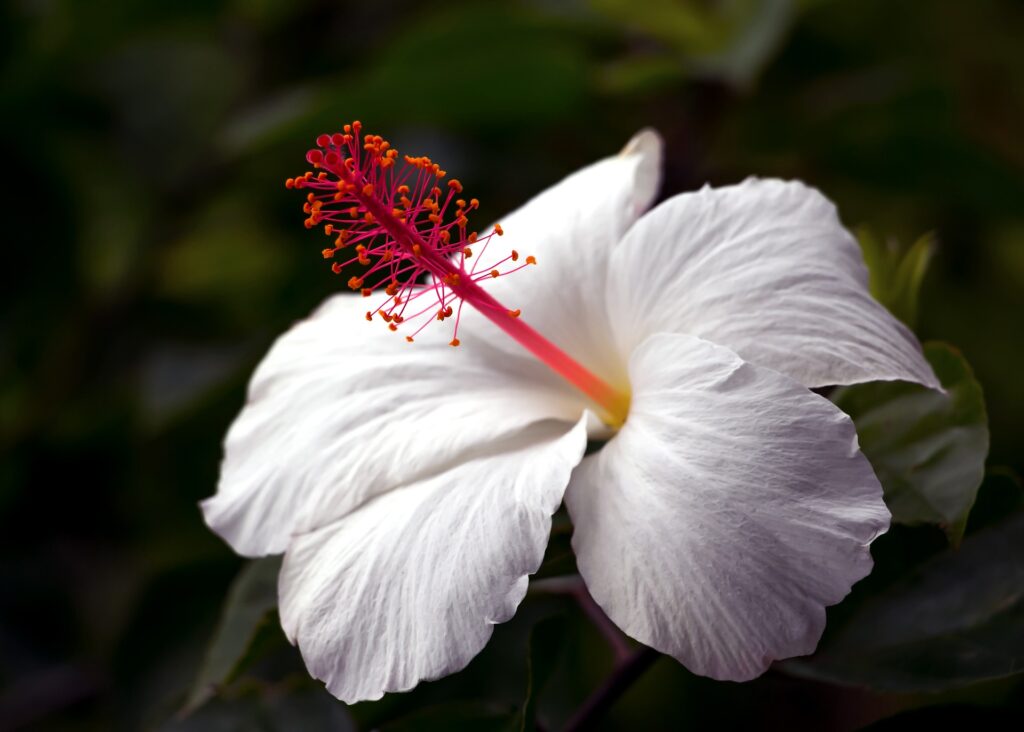
Tropical hibiscus are easy-care plants that add another layer of exotic beauty to your garden while enjoying similar growing conditions. They come in a range of vivid colors that will harmonize with plumbago into a stunning tropical display.
These plant suggestions share similar requirements with Plumbago, ensuring harmonious growth and care. When combined, they create an alluring landscape with a diverse range of colors, textures, and forms. Always consider the mature size of each plant and their compatibility in terms of growth habits and maintenance to achieve a well-balanced and cohesive garden design.
Reliable Beauty
With its ease of care, consistent and abundant flowering, and evergreen foliage in mild climates, plumbago is a reliable tropical beauty in the Gulf Coast garden. With a little pampering during the first three years of establishment, plumbago is a visually stunning addition to your garden.
Visit our Etsy shop for Blue Plumbago, Duranta, Pentas, and other perennial flowering plants for your butterfly garden.
FAQ – Frequently Asked Questions About Growing Plumbago
Is plumbago easy to grow?
Yes, Plumbago is generally considered an easy-to-grow plant, especially in tropical and subtropical regions, given its tolerance for various soil types, adaptable nature, and relatively low maintenance requirements.
What month does plumbago bloom?
Plumbago typically blooms from late spring to fall, depending on the mildness of your winter.
Do hummingbirds like plumbago?
Yes, hummingbirds are attracted to the tubular flowers of Plumbago and often visit them for nectar, making it a favorite plant for hummingbird enthusiasts.
Which butterflies, months, and other insects like plumbago?
Plumbago attracts various butterflies, including species such as Zebra Blue (Leptotes plinius), Common Blue (Polyommatus icarus), and other pollinators. The specific months of butterfly activity can vary based on the region, but generally, the warmer months from spring to fall are when butterflies are most active around Plumbago. Additionally, bees and other beneficial insects are also attracted to the nectar-rich flowers of Plumbago.
When should you plant plumbago?
Plumbago can be planted in the spring after the last frost date, as it thrives in warm weather. This allows the plant to establish itself and take advantage of the growing season.
Where is the best place to plant plumbago?
The best place to plant Plumbago is in a location that receives full sun to partial shade.
How do you keep plumbago blooming?
To keep Plumbago blooming, provide it with full sun to partial shade, regular watering, well-draining soil, and regular fertilization with a bloom-boosting fertilizer.
When should you prune plumbago?
Plumbago should be pruned in late winter or early spring before new growth emerges. This timing allows for rejuvenation, shaping, and stimulating new growth for the upcoming growing season.
Does plumbago come back every year?
Yes, Plumbago is a perennial plant that typically comes back every year in suitable growing conditions. It is an evergreen in subtropical and tropical climates.
How do you winterize blue plumbago?
To winterize blue Plumbago, provide a layer of organic mulch around the base of the plant to insulate the roots, and cover the plant with a frost cloth or blanket during freezing temperatures.
Should you cut back plumbago?
Yes, it is beneficial to cut back Plumbago in late winter or early spring before new growth emerges. Pruning helps maintain a compact shape, encourages new growth, and stimulates abundant flowering. You can also cut it back during summer if it overgrows its allotted space.
How do you make plumbago bushy?
To make Plumbago bushy, prune it back by about one-third of its height in late winter or early spring before new growth begins. This encourages branching and promotes a more compact, bushy growth habit.
What other ornamental plants pair well with plumbago?
Several ornamental plants pair well with Plumbago to create a visually appealing garden. Some suitable companions include Lantana, Pentas, Mexican Bush Sage, Duranta, Dwarf Poinciana, and other flowering perennials that share similar soil, light, and water requirements.
How big does plumbago get?
Plumbago can reach an average height of 6 to 10 feet (1.8 to 3 meters) and have a spread of 6 to 8 feet (1.8 to 2.4 meters), depending on the specific species and growing conditions.




[…] delicate blue flowers of Plumbago complement the colors of Golden Dewdrop and both plants thrive in similar […]